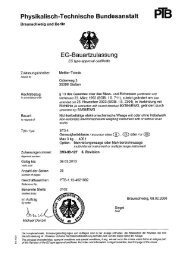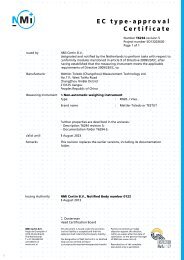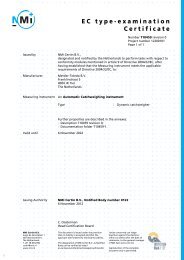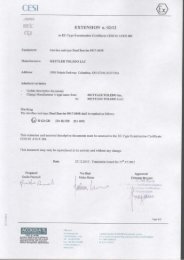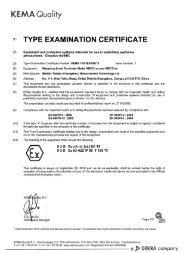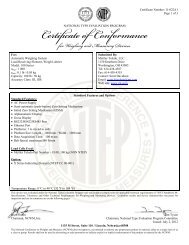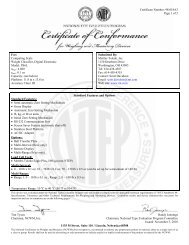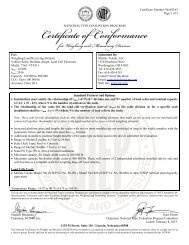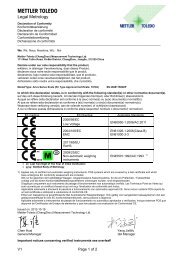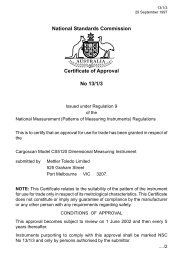Certificate of Approval No 6/4C/228 - Mettler Toledo
Certificate of Approval No 6/4C/228 - Mettler Toledo
Certificate of Approval No 6/4C/228 - Mettler Toledo
Create successful ePaper yourself
Turn your PDF publications into a flip-book with our unique Google optimized e-Paper software.
6/<strong>4C</strong>/<strong>228</strong><br />
19 October 2004<br />
12 Lyonpark Road, <strong>No</strong>rth Ryde NSW 2113<br />
<strong>Certificate</strong> <strong>of</strong> <strong>Approval</strong><br />
<strong>No</strong> 6/<strong>4C</strong>/<strong>228</strong><br />
Issued by the Chief Metrologist under Regulation 60<br />
<strong>of</strong> the<br />
National Measurement Regulations 1999<br />
This is to certify that an approval for use for trade has been granted in respect <strong>of</strong> the<br />
<strong>Mettler</strong> <strong>Toledo</strong> Model PB3002-S DR Weighing Instrument<br />
submitted by<br />
<strong>Mettler</strong> <strong>Toledo</strong> Limited<br />
220 Turner Street<br />
Port Melbourne VIC 3207.<br />
NOTE: This <strong>Certificate</strong> relates to the suitability <strong>of</strong> the pattern <strong>of</strong> the instrument for<br />
use for trade only in respect <strong>of</strong> its metrological characteristics. This <strong>Certificate</strong> does<br />
not constitute or imply any guarantee <strong>of</strong> compliance by the manufacturer or any other<br />
person with any requirements regarding safety.<br />
CONDITIONS OF APPROVAL<br />
This approval becomes subject to review on 1 <strong>No</strong>vember 2009, and then every<br />
5 years thereafter.<br />
Instruments purporting to comply with this approval shall be marked with approval<br />
number ‘NMI 6/<strong>4C</strong>/<strong>228</strong>’ and only by persons authorised by the submittor.<br />
..../2
6/<strong>4C</strong>/<strong>228</strong><br />
19 October 2004<br />
<strong>Certificate</strong> <strong>of</strong> <strong>Approval</strong> <strong>No</strong> 6/<strong>4C</strong>/<strong>228</strong> Page 2<br />
It is the submittor’s responsibility to ensure that all instruments marked with this<br />
approval number are constructed as described in the documentation lodged with the<br />
National Measurement Institute (NMI) and with the relevant <strong>Certificate</strong> <strong>of</strong> <strong>Approval</strong><br />
and Technical Schedule. Failure to comply with this Condition may attract penalties<br />
under Section 19B <strong>of</strong> the National Measurement Act and may result in cancellation or<br />
withdrawal <strong>of</strong> the approval, in accordance with document NMI P 106.<br />
The National Measurement Institute reserves the right to examine any instrument or<br />
component <strong>of</strong> an instrument purporting to comply with this approval.<br />
Auxiliary devices used with this instrument shall comply with the requirements <strong>of</strong><br />
General Supplementary <strong>Certificate</strong> <strong>No</strong> S1/0/A.<br />
DESCRIPTIVE ADVICE<br />
Pattern: approved 8 October 2004<br />
• The <strong>Mettler</strong> <strong>Toledo</strong> model PB3002-S DR self-indicating non-automatic weighing<br />
instrument <strong>of</strong> high accuracy class <strong>of</strong> 3100 g maximum capacity.<br />
Variants: approved 8 October 2004<br />
1. Model PB303-S DR high accuracy class instrument as listed in Table 1.<br />
2. Certain other models <strong>of</strong> the PB high accuracy instruments as listed in Table 2.<br />
3. Certain models <strong>of</strong> the AB special accuracy class instruments as listed in<br />
Table 3.<br />
4. Certain models <strong>of</strong> the JB high accuracy and special accuracy class instruments<br />
as listed in Table 4.<br />
5. Model PB8000-S medium accuracy class instrument.<br />
Technical Schedule <strong>No</strong> 6/<strong>4C</strong>/<strong>228</strong> describes the pattern and variants 1 to 5.<br />
FILING ADVICE<br />
The documentation for this approval comprises:<br />
<strong>Certificate</strong> <strong>of</strong> <strong>Approval</strong> <strong>No</strong> 6/<strong>4C</strong>/<strong>228</strong> dated 19 October 2004<br />
Technical Schedule <strong>No</strong> 6/<strong>4C</strong>/<strong>228</strong> dated 19 October 2004 (incl. Tables 1 to 4,<br />
and Test Procedure)<br />
Figures 1 to 3 dated 19 October 2004<br />
Signed by a person authorised by the Chief Metrologist<br />
to exercise his powers under Regulation 60 <strong>of</strong> the<br />
National Measurement Regulations 1999.
6/<strong>4C</strong>/<strong>228</strong><br />
19 October 2004<br />
TECHNICAL SCHEDULE <strong>No</strong> 6/<strong>4C</strong>/<strong>228</strong><br />
Pattern:<br />
Submittor:<br />
<strong>Mettler</strong> <strong>Toledo</strong> Model PB3002-S DR Weighing Instrument<br />
<strong>Mettler</strong> <strong>Toledo</strong> Limited<br />
220 Turner Street<br />
Port Melbourne VIC 3207<br />
1. Description <strong>of</strong> Pattern<br />
The <strong>Mettler</strong> <strong>Toledo</strong> model PB3002-S DR (#) self-indicating non-automatic weighing<br />
instrument <strong>of</strong> high accuracy class <strong>of</strong> 3100 g maximum capacity (Figure 1 and<br />
Table 1). (# – The instrument model number may include an ‘/A’ suffix.)<br />
Instruments use electromagnetic force compensation technology and have a liquid<br />
crystal display (LCD).<br />
These single range instruments have a verification scale interval (e) <strong>of</strong> 0.1 g. They<br />
are fitted with a feature (known as ‘DeltaRange’ ®) in which a differentiated scale<br />
interval (d) <strong>of</strong> 0.01 g operates within a range <strong>of</strong> 600 g (plus up to 9e, i.e. 600.9 g) <strong>of</strong><br />
the current zero or tare position, i.e. up to 600 g net). Above this range the differentiated<br />
scale interval does not appear.<br />
Instruments are approved for use over a temperature range <strong>of</strong> +10 o C to +30 o C, and<br />
are so marked.<br />
Instruments are not for trading direct with the public, and are so marked.<br />
Some instruments may have a windshield provided over the load receptor.<br />
The AC/DC mains adaptor supplied was an APX Technologies model AP2805EP power<br />
supply (12 V DC, 1 A); the submittor should be consulted regarding the acceptability<br />
<strong>of</strong> alternative power supply units.<br />
Instruments may be fitted with output sockets (output interfacing capability) for the<br />
connection <strong>of</strong> auxiliary and/or peripheral devices.<br />
1.1 Zero and Tare<br />
Instruments have an initial zero-setting device with a nominal range <strong>of</strong> not more than<br />
20% <strong>of</strong> the maximum capacity <strong>of</strong> the instrument.<br />
Instruments have a combined semi-automatic zero-setting and subtractive tare<br />
balancing device (operated by the ‘0/T’ key). The subtractive taring device operates<br />
up to the maximum capacity <strong>of</strong> the instrument.<br />
A zero-tracking device may also operate to automatically correct to within ±0.25e (or<br />
±0.5d where d
6/<strong>4C</strong>/<strong>228</strong><br />
19 October 2004<br />
Technical Schedule <strong>No</strong> 6/<strong>4C</strong>/<strong>228</strong> Page 2<br />
1.3 Management Functions<br />
Instruments may be fitted with a number <strong>of</strong> additional functions which display values<br />
that are not weighing results, including counting, percentage, and ‘dynamic weighing’.<br />
The displays <strong>of</strong> such values are identified by symbols, e.g. percentage by ‘%’.<br />
These functions and displays are not approved for trade use.<br />
1.4 Display Check<br />
A display check is initiated when the instruments are switched on.<br />
1.5 Levelling<br />
Instruments are provided with adjustable feet and a level indicator, adjacent to which<br />
is a level notice stating “Instrument must be level when in use”, or similar wording.<br />
1.6 Internal Calibration System<br />
Instruments are fitted with an internal ‘calibration’ system. This comprises an internal<br />
calibration mass that may be applied to the instrument in an automatic adjustment<br />
cycle that is initiated automatically whenever the instrument is switched on, or manually<br />
by pressing the ‘Cal/Menu’ key.<br />
1.7 Descriptive Markings and <strong>No</strong>tices<br />
The instrument model number is shown on the instrument nameplate.<br />
Instruments carry the following markings:<br />
Manufacturer’s mark, or name written in full <strong>Mettler</strong> <strong>Toledo</strong><br />
Name or mark <strong>of</strong> manufacturer’s agent ....................<br />
Indication <strong>of</strong> accuracy class<br />
Pattern approval mark for the instrument NMI 6/<strong>4C</strong>/<strong>228</strong><br />
Manufacturer’s designation (model number) .................... #<br />
Maximum capacity Max ............ g *<br />
Minimum capacity Min ............. g *<br />
Verification scale interval e = .............. g *<br />
Actual scale interval d = .............. g *<br />
Serial number <strong>of</strong> the instrument ....................<br />
Special temperature limits<br />
+10 o C to +30 o C<br />
# The instrument model number may include an ‘/A’ suffix.<br />
* These markings shall also be shown near the display <strong>of</strong> the result if they<br />
are not already located there.<br />
Instruments are not for trading direct with the public, and are so marked.<br />
1.8 Verification/Certification Provision<br />
Provision is made for the application <strong>of</strong> a verification/certification mark.<br />
..../3
6/<strong>4C</strong>/<strong>228</strong><br />
19 October 2004<br />
Technical Schedule <strong>No</strong> 6/<strong>4C</strong>/<strong>228</strong> Page 3<br />
1.9 Sealing Provision<br />
Sealing <strong>of</strong> the calibration adjustment is provided by the use <strong>of</strong> destructible adhesive<br />
labels on the rear <strong>of</strong> the instrument to prevent access to the calibration switch, and to<br />
prevent separation <strong>of</strong> the casing <strong>of</strong> the instrument (Figure 2).<br />
Sealing <strong>of</strong> the instrument does not prevent operation <strong>of</strong> the internal calibration system.<br />
However the instrument uses data regarding the value <strong>of</strong> the internal mass, and<br />
alteration <strong>of</strong> that data is prevented.<br />
2. Description <strong>of</strong> Variants<br />
2.1 Variant 1<br />
Model PB303-S DR weighing instrument <strong>of</strong> high accuracy class<br />
Table 1, having the features <strong>of</strong> the pattern including ‘DeltaRange’®.<br />
as listed in<br />
2.2 Variant 2<br />
Certain other models <strong>of</strong> the PB series weighing instruments <strong>of</strong> high accuracy class<br />
as listed in Table 2 and which are not fitted with the ‘DeltaRange’® feature described<br />
for the pattern.<br />
2.3 Variant 3<br />
Certain models <strong>of</strong> the AB series weighing instruments as listed in Table 3.<br />
Instruments are approved special accuracy class and are so marked.<br />
The models AB135-S and AB265-S as listed in Table 3 are multi-interval instruments<br />
with two partial weighing ranges. (<strong>No</strong>te that these instruments are known by <strong>Mettler</strong><br />
<strong>Toledo</strong> as ‘DualRange’®).<br />
2.3.1 Sealing Provision<br />
Sealing <strong>of</strong> the calibration adjustments <strong>of</strong> special accuracy class instruments is<br />
not required.<br />
2.4 Variant 4<br />
Certain models <strong>of</strong> the JB series weighing instruments as listed in Table 4 and as<br />
described below:<br />
(i) Having the features <strong>of</strong> the pattern except ‘DeltaRange’®.<br />
Instruments are approved as high accuracy class and are so marked.<br />
..../4
6/<strong>4C</strong>/<strong>228</strong><br />
19 October 2004<br />
Technical Schedule <strong>No</strong> 6/<strong>4C</strong>/<strong>228</strong> Page 4<br />
(ii) Models JB203-C and JB803-C weighing instruments as listed in Table 4, having<br />
the features <strong>of</strong> the pattern except ‘DeltaRange’® and which are approved to<br />
operate with metric carat units.<br />
Instruments are approved high accuracy class and are so marked.<br />
Instruments may be operated in a mode using units <strong>of</strong> metric carats (1 metric<br />
carat = 0.2 g). This may either be instead <strong>of</strong>, or in addition to, operation with<br />
units <strong>of</strong> grams (g). The symbol ‘ct’ indicates when the units are metric carats.<br />
Instruments may operate in kilograms (kg), grams (g), milligrams (mg) or metric<br />
carats (ct) units – use <strong>of</strong> other units is not approved for trade use.<br />
An instrument that can be operated in the metric carat mode shall carry markings<br />
in metric carats (in addition to markings in grams if gram units are also available).<br />
(iii) Models JB1003-C and JB1603-C weighing instruments as listed in Table 4,<br />
having the features <strong>of</strong> the pattern except ‘DeltaRange’® and which are approved<br />
to operate in metric carat mode as described above.<br />
Instruments are approved as special accuracy class when in metric carat<br />
mode and as high accuracy class when operating with units <strong>of</strong> grams, and<br />
are so marked.<br />
Figure 3 shows a typical JB series instrument with a windshield.<br />
2.4.1 Sealing Provision<br />
For high accuracy class instruments, sealing is as described in clause<br />
1.9 Sealing Provision for the pattern.<br />
Sealing <strong>of</strong> the calibration adjustments <strong>of</strong> special accuracy class instruments is<br />
not required.<br />
2.5 Variant 5<br />
Model PB8000-S weighing instrument <strong>of</strong> 8100 g maximum capacity, with a verification<br />
scale interval (e) and scale interval (d) <strong>of</strong> 1 g. The subtractive taring device operates<br />
up to the maximum capacity <strong>of</strong> the instrument.<br />
Instruments are approved as medium accuracy class and are so marked.<br />
Instruments are approved for use over a temperature range <strong>of</strong> +10 o C to +40 o C, and<br />
are so marked.<br />
2.5.1 Sealing Provision<br />
Sealing is as described in clause 1.9 Sealing Provision for the pattern.<br />
..../5
6/<strong>4C</strong>/<strong>228</strong><br />
19 October 2004<br />
Technical Schedule <strong>No</strong> 6/<strong>4C</strong>/<strong>228</strong> Page 5<br />
TEST PROCEDURE<br />
Instruments should be tested in accordance with any relevant tests specified in the<br />
Uniform Test Procedures.<br />
Maximum Permissible Errors at Verification/Certification<br />
For special accuracy class instruments, the maximum permissible errors for<br />
increasing and decreasing loads on initial verification/certification for loads, m,<br />
expressed in verification scale intervals, e, are:<br />
±0.5 e for loads 0 ≤ m ≤ 50 000;<br />
±1.0 e for loads 50 000 < m ≤ 200 000; and<br />
±1.5 e for loads 200 000 < m.<br />
For high accuracy class instruments, the maximum permissible errors for<br />
increasing and decreasing loads on initial verification/certification for loads, m,<br />
expressed in verification scale intervals, e, are:<br />
±0.5 e for loads 0 ≤ m ≤ 5 000;<br />
±1.0 e for loads 5 000 < m ≤ 20 000; and<br />
±1.5 e for loads 20 000 < m ≤ 100 000.<br />
For medium accuracy class instruments, the maximum permissible errors for<br />
increasing and decreasing loads on initial verification/certification for loads, m,<br />
expressed in verification scale intervals, e, are:<br />
±0.5 e for loads 0 ≤ m ≤ 500;<br />
±1.0 e for loads 500 < m ≤ 2 000; and<br />
±1.5 e for loads 2 000 < m ≤ 10 000.<br />
For multi-interval instruments with verification scale intervals <strong>of</strong> e 1<br />
, e 2<br />
…, apply e 1<br />
for<br />
zero adjustment, and for maximum permissible errors apply e 1<br />
, e 2<br />
, …, as applicable<br />
for the load.<br />
For multiple range instruments with verification scale intervals e 1<br />
, e 2<br />
, …, apply e 1<br />
, for<br />
zero adjustment, and for maximum permissible errors apply e 1<br />
, e 2<br />
, …, as applicable<br />
for the load.<br />
Ensure that instruments are only being used within the special temperature limits<br />
stated elsewhere in this Technical Schedule.<br />
For instruments with an internal self-calibration facility<br />
Prior to verification/certification ensure that the instrument has been adjusted by the<br />
internal self-calibration system by pressing the ‘Cal/Menu’ key until ‘Cal int’ appears,<br />
and then allow the calibration procedure to proceed to completion (with no load on<br />
the platter).<br />
..../6
6/<strong>4C</strong>/<strong>228</strong><br />
19 October 2004<br />
Technical Schedule <strong>No</strong> 6/<strong>4C</strong>/<strong>228</strong> Page 6<br />
TABLE 1<br />
Model Maximum Minimum Verification Scale<br />
Number Capacity Capacity Scale Interval Interval<br />
(Max) g (Min) g (e) g (d) g<br />
PB 303-S DR 60 0.02 0.01 0.001<br />
310 0.01 0.01<br />
PB 3002-S DR 600 0.5 0.1 0.01<br />
3100 0.1 0.1<br />
Approved models <strong>of</strong> the PB series high accuracy class<br />
with the ‘DeltaRange’® feature<br />
TABLE 2<br />
Model Maximum Minimum Verification Scale<br />
Number Capacity Capacity Scale Interval Interval<br />
(Max) g (Min) g (e) g (d) g<br />
PB 153-S 151 0.02 0.01 0.001<br />
PB 303-S 310 0.02 0.01 0.001<br />
PB 403-S 410 0.02 0.01 0.001<br />
PB 602-S 610 0.5 0.1 0.01<br />
PB 603-S 610 0.02 0.01 0.001<br />
PB 1501-S 1510 5 0.1 0.1<br />
PB 1502-S 1510 0.5 0.1 0.01<br />
PB 3001-S 3100 5 0.1 0.1<br />
PB3002-S 3100 0.5 0.1 0.01<br />
PB 4002-S 4100 0.5 0.1 0.01<br />
PB5001-S 5100 5 1 0.1<br />
PB 8001-S 8100 5 1 0.1<br />
PB 8000-S 8100 50 1 1<br />
Approved models <strong>of</strong> the PB series high accuracy class<br />
without the ‘DeltaRange’® feature<br />
..../7
6/<strong>4C</strong>/<strong>228</strong><br />
19 October 2004<br />
Technical Schedule <strong>No</strong> 6/<strong>4C</strong>/<strong>228</strong> Page 7<br />
TABLE 3<br />
Model Maximum Minimum Verification Scale<br />
Number Capacity Capacity Scale Interval Interval<br />
(Max) g (Min) g (e) g (d) g<br />
AB 54-S 51 0.01 0.001 0.0001<br />
AB 104-S 110 0.01 0.001 0.0001<br />
AB 204-S 220 0.01 0.001 0.0001<br />
AB 304-S 320 0.01 0.001 0.0001<br />
Approved models <strong>of</strong> the AB series special accuracy class<br />
without DualRange® feature<br />
AB 135-S 31 0.001 0.001 0.00001<br />
120 0.001 0.0001<br />
AB 265-S 61 0.001 0.001 0.00001<br />
220 0.001 0.0001<br />
Approved models <strong>of</strong> the AB series special accuracy class<br />
with DualRange® feature<br />
TABLE 4<br />
Model Maximum Minimum Verification Scale Accuracy<br />
Number Capacity Capacity Scale Interval Interval Class (#)<br />
(Max) (Min) (e) (d)<br />
JB 603-G 610 g 0.02 g 0.01 g 0.001 g high<br />
JB 3002-G 3100 g 0.5 g 0.1 g 0.01 g high<br />
JB 4002-G 4100 g 0.5 g 0.1 g 0.01 g high<br />
JB 8001-G 8100 g 5 g 1 g 0.1 g high<br />
Approved models <strong>of</strong> the JB series without metric carat mode feature<br />
JB 203-C 51 g 0.02 g 0.01 g 0.001 g high<br />
255 ct 0.02 ct 0.01 ct 0.001 ct high<br />
JB 803-C 162 g 0.02 g 0.01 g 0.001 g high<br />
810 ct 0.02 ct 0.01 ct 0.001 ct high<br />
JB 1003-C 220 g 0.02 g 0.01 g 0.001 g high<br />
1100 ct 0.1 ct 0.01 ct 0.001 ct special<br />
JB 1603-C 320 g 0.02 g 0.01 g 0.001 g high<br />
1600 ct 0.1 ct 0.01 ct 0.001 ct special<br />
Approved models <strong>of</strong> the JB series with metric carat mode feature<br />
(#) special accuracy class – high accuracy class
6/<strong>4C</strong>/<strong>228</strong><br />
19 October 2004<br />
FIGURE 6/<strong>4C</strong>/<strong>228</strong> – 1<br />
<strong>Mettler</strong> <strong>Toledo</strong> Model PB3002-S DR Weighing Instrument
6/<strong>4C</strong>/<strong>228</strong><br />
19 October 2004<br />
FIGURE 6/<strong>4C</strong>/<strong>228</strong> – 2<br />
Destructible Label<br />
Provision for Verification/Certification Mark<br />
Destructible Label<br />
Showing Sealing <strong>of</strong> Typical High Accuracy Class<br />
Instrument
6/<strong>4C</strong>/<strong>228</strong><br />
19 October 2004<br />
FIGURE 6/<strong>4C</strong>/<strong>228</strong> – 3<br />
Typical <strong>Mettler</strong> <strong>Toledo</strong> JB Series Weighing Instrument



